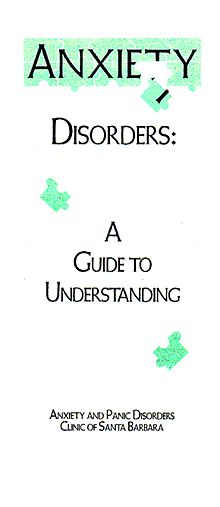|
|
Other
|
 |
 Anxiety and Panic Disorders Clinic
of Santa Barbara
What are Anxiety Disorders?
Panic Disorder: is characterized by four or more panic attacks in a month, or one or more panic attacks followed by persistent fear of experiencing another.
A panic attack is a period of intense fear or discomfort characterized by the kind of thoughts and sensations that one would experience if faced with immediate danger.
Symptoms can include shortness of breath, dizziness, heart palpitations, numbness, feelings of unreality, or nausea. Often, people suffering a panic attack believe they are dying or losing control of themselves.
Agoraphobia: a complex set of fears and avoidance behaviors associated with being alone or feeling trapped in a public place.
Agoraphobia frequently occurs in combination with panic disorder.
Agoraphobia can be so debilitating that some individuals become completely housebound. Those who experience this condition may find that situations such as driving, using elevators, going into stores, or traveling long distances, arouse intense anxiety and panic.
Obsessive‑Compulsive Disorder (OCD): recurrent and persistent images or thoughts (obsessions) that the individual finds very disturbing.
Usually, people with OCD feel compelled to perform some routine or ritual (compulsion) that helps relieve the anxiety brought on by the obsession. However, relief is only temporary and results in repetitive, time‑consuming rituals which significantly interfere with daily functioning.
The most common obsessions are exactness, doubt, fear of contamination, and thoughts or images of violence. The most common compulsions include cleaning, handwashing, checking, hoarding, counting and repeating.
Simple or Single Phobia: an involuntary fear reaction that is inappropriate to the situation.
It involves a sense of dread so intense that suffering individuals do everything possible to avoid the feared object or situation. Fear of certain types of animals is the most common simple phobia. Other phobias include fear of flying, closed spaces, heights, driving, dentist visits, blood or injections.
Social Anxiety and Phobia: an intense fear of being negatively evaluated by others or of behaving in a way that will lead to embarrassment or ridicule.
The most common social phobias are fear of public speaking, social events, eating in front of others or using public restrooms.
Generalized Anxiety Disorder (GAD): unrealistic anxiety and excessive worry about two or more life circumstances.
People with GAD find it difficult to control or stop their worrying. Symptoms such as irritability, muscle tension, difficulty concentrating, fatigue, feeling keyed‑up, hypervigilance, restlessness, and/or sleep disturbances characterize this disorder.
Anxiety Disorders in Children:
Separation anxiety disorder: excessive anxiety or panic because of routine separation from parents, caregivers, home, or other familiar situations.
Overanxious disorder: excessive and unrealistic worry about social events, school performance or athletic abilities.
Avoidant disorder: severe shyness and avoidance of other children, interfering with the development of normal social relationships beyond the immediate family. |
 |
Anxiety and Panic Disorders Clinic
What are Anxiety Disorders?
Treatment
|
